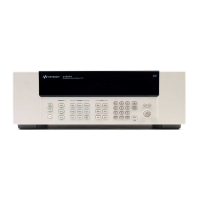Calibration Procedures 3
34980A Service Guide 55
DMM Test Considerations
Errors may be induced by ac signals present on the input leads during a self-test. Long
test leads can also act as an antenna causing pick-up of ac signals.
For optimum performance, all procedures should comply with the following
recommendations:
• Assure that the calibration ambient temperature is stable and
between 18 °C and 28 °C. Ideally the calibration should be
performed at 23 °C ±1 °C.
• Assure ambient relative humidity is less than 80%.
• Allow a 1.5-hour warm-up period with a copper short connecting pins 3, 4, 8, and 9
of the ABus connector. Connector pinout is shown in the figure on page 54.
• Use shielded twisted pair PTFE insulated cables to reduce settling and noise errors.
Keep the input cables as short as possible.
• Connect the input cable shield to the source LO output. Except where noted in the
procedures, connect the calibrator LO source to earth ground.
• Either remove all modules from the mainframe, or reset the modules to ensure no
module is connected to the backplane ABus.
Because the instrument is capable of making highly accurate measurements, you must
take special care to ensure that the calibration standards and test procedures used do not
introduce additional errors. Ideally, the standards used to verify and adjust the instrument
should be an order of magnitude more accurate than each instrument range full scale
error specification.
For the dc voltage, dc current, and resistance gain verification measurements, you should
take care to ensure the calibrator’s “0” output is correct. If necessary, the measurements
can be referenced to the calibrator’s “0” output using Mx + B scaling (see Chapter 2 in
the 34980A User's Guide). You will need to set the offset for each range of the
measuring function being verified.
Internal DMM Verification Tests
Zero Offset Verification
This procedure is used to check the zero offset performance of the internal DMM.
Verification checks are only performed for those functions and ranges with unique offset
calibration constants. Measurements are checked for each function and range as
described in the procedure on the next page.

